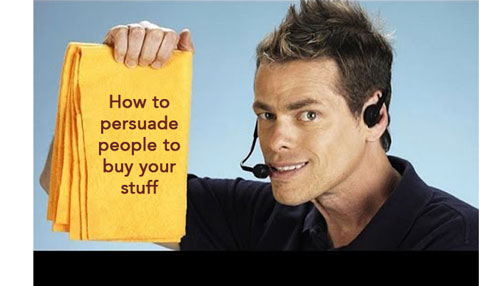
How infomercials use the persuasive “science” to influence and motivate their target audience to buy.
Have you ever sat through an infomercial?
About 20 minutes into the “show”, you find you’re reaching for your wallet for not ONE set of widgets you never needed 30 minutes ago, but you get TWO sets of widgets. Right?
I’m fascinated by infomercials because their formula nail sales down persuasive ways to influence people to buy things (they don’t often need).
If you really study them, you’ll find they follow a similar pattern:
- They identify the problem/pain that you’re dealing with today. (Build awareness)
- Their story describes the specific benefits of their product/service to help solve those problems. The content is aspirational for the viewer. Wouldn’t you LOVE to have the same product/service too? (Generate interest)
- They address the top objections. (Address barriers to buy)
- They feature enthusiastic testimonials to counter those objections and share how this product/service changed their lives. (Provide social proof)
- Benefits and testimonials are typically repeated three times during the infomercial. They highlight various perspectives of you are now (with the problem) versus how much easier your life could be with this product/service. Repetition builds momentum and increases desire.
- They often address emotion within the context of how this product will help you. (i.e. How does that feel?)
- They do not announce the cost until they are close to the end of the presentation. They build desire until the viewer is hooked and then announce the price (call-to-action): “3 easy payments of $59.99!”
- They often offer bonuses to build on the perceived value of what you are buying (But wait…there’s MORE! You don’t just get two widgets you never thought you needed, you get FOUR!)
- There is also a money-back guarantee that provides a low barrier of entry to buy.
- And, if you buy within the next 5 minutes, you’ll also receive…… . There can also be a bonus offer within a limited timeframe to make you feel like you’ll miss out if you don’t take action now. (Scarcity)
You can also use some of these persuasive techniques to make your product/service/idea more appealing.
Here’s how:
Step #1: Write blog posts or videos that address a specific problem or pain your target audience is having.
Step #2: Acknowledge or address your audience’s objections or deepest fears. What prevents them from taking action?
Step #3: Provide proof that you are providing the perfect solution. Highlight the benefits and identify what makes your product/service/idea different than everyone else’s.
Step #4: Include some “social proof”. Testimonials work GREAT here. How did someone else take action and your product/service/idea changed their life for the better?
Step #5: Reassure your audience that they will feel much better once they’ve taken action. Offer some sort of guarantee (and be sure to stand behind that guarantee) that eliminates the barrier to purchase.
Step #6: Over-deliver on the results. Knock it out of the park, and be sure to provide “through the roof” customer service.
Step #7: When you follow up with your client to inquire how they are doing, for positive feedback, ask them “Can I quote you on that?” or “Can I use this testimonial as a part of my marketing program?”. For negative feedback, take action to make things right.
When they are giving you great feedback, you may also wish to ask “Do you know anyone else who might benefit as well?” so that you can build a network of referrals. (Perhaps even ask them to introduce you to that person on LinkedIn!)
The next time you watch an infomercial, see if you can identify the pattern listed above, and see where you can apply the same principles of influence to your marketing messages.
If the Sham-Wow guy could do it, so can you!
Did this post help? If so, please share it with your network and add your feedback below.
 Leslie Hughes is a LinkedIn Optimization Specialist, Professor of Social Media, Corporate Trainer and Principal of PUNCH!media
Leslie Hughes is a LinkedIn Optimization Specialist, Professor of Social Media, Corporate Trainer and Principal of PUNCH!media
Leslie was called a “Social Media Guru” by CBC Radio and has been working in digital marketing since 1997 and founded PUNCH!media in 2009. PUNCH!media clients include The Children’s Wish Foundation of Canada, Guardian Life Insurance Company of America and TVO.
PUNCH!media’s goal is to empower through education and help executives gain confidence in their online presence so you convert higher-paying clients.
Leslie provides LinkedIn corporate training and LinkedIn profile writing for executives and teams who need a strong, powerful presence online.
www.punchmedia.ca
